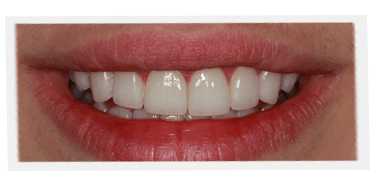
In Part 1 of Smile Design, we looked at how the Smile Line and Relative Dental Proportions play a central role in determining the design of a smile. Now, we move on to #3 and #4, below. (Taken below from my book, A Guide to the Perfect Smile.)
#3 Dominance of Maxillary Central Incisors
The First thing the eye focuses on when it looks at a smile are the two upper front teeth – the maxillary central incisors – together as one. If the eye does not accept these two teeth properly, it assumes that something is wrong with the whole smile. These two teeth have to work as a unit. The eye of the viewer of the smile will be thrown off if they don’t match – if one is twisted or shorter, for example. People looking at such a smile automatically begin to scan left and right, picking up all of the other differences. (Interestingly, two well-proportioned front teeth will to a large extend make up for crookedness in the other teeth.)
Going back briefly to our discussion of the Golden Mean in the previous chapter, it becomes clear why the central incisors are a norm that is critical to our perception of a smile. A central incisor that has an 80% width-to-height ratio is in a 1 to .8 relationship. However, the two central incisors together form a Golden Rectangle, with the coveted Phi factor of 1 to 1.6.
A pleasing smile, therefor, must have maxillary incisors that dominate the smile. This principle advocates an ideal width-to-height for the maxillary central incisor. Interestingly, there are the only two teeth in the entire smile for which mirror-image symmetry is a must.
Note that the height of teeth can change over time. An unworn tooth may actually be 75% width to height. But because some wear is common, we use 80% as the standard, which is actually a shorter tooth, width to height. Height can appear to change because of changes to the gum line, as well, thus creating a different illusion as to the true height to the tooth.
The width of teeth, however, rarely changes. You can’t floss the width of your tooth off. From the width of one central incisor, you can easily establish the desired height of the two teeth from gum line to incisal edge. Since these two teeth are identical, you can establish the relative dental proportions of the remaining front teeth. As mentioned, the upper teeth are critically important to the character of the smile, which is why they are called the social six.
#4 Silhouettes
There are two sets of silhouettes, an anterior one and a posterior one. The anterior silhouette may be described as the relationship of the front upper four teeth to each other. Specifically, the particular angle or curve of the back side of your front central incisor should perfectly mirror the back angle or curve of your lateral incisor, the second tooth. If the front two teeth, the central incisors, are a mirror image of each other, this silhouette pattern will mirror on its other sides as well, creating a harmony between the front four maxillary teeth.
The posterior silhouette may be described as the particular line angle of your cuspid, the third tooth from the midline. The angle of each tooth that follows, as you go to the teeth in the back of the mouth, the premolars and the molars, needs to mirror this line angle.
The line angles of some people’s teeth range from straight to a continuous curve, or even begin straight and then end curved. But whatever shape one tooth has, the teeth that follow need to have the same silhouette.
Therefore, it’s not the particular line angle that’s considered aesthetic but rather how the angles all silhouette together. Ideally, the anterior set of silhouettes match each other and the posterior sets of silhouettes match each other.
Patients often notice that when individual teeth are bonded, veneered, or crowned, they tend to look artificial, even when the color matches perfectly. Invariably, what the eye is seeing is a lack of this principle of silhouettes. Because these procedures are inherently adding thickness to the existing size of the tooth, the result often does not silhouette.



